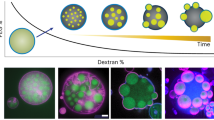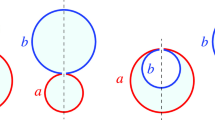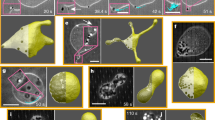Abstract
A chemo-mechanical model is used to capture the formation and evolution of microdomains on the deforming surface of giant unilamellar vesicles. The model is intended for the regime of vesicle dynamics characterized by a distinct difference in time scales between shape change and species transport. This is achieved by ensuring that shape equilibrium holds away from chemical equilibrium. Conventional descriptions are used to define the curvature and chemical contributions to the vesicle energetics. Both contributions are consistently non-dimensionalized. The phase-field framework is used to cast the coupled model in a diffuse-interface form. The resulting fourth-order nonlinear system of equations is discretized using the finite- element method with a uniform cubic spline basis, which satisfies global higher-order continuity. Two-dimensional and axisymmetric numerical examples of domain evolution coupled to vesicle shape deformation are presented. Curvature-dependent domain sorting and shape deformation dominated by line tension are also considered.
Similar content being viewed by others
References
Adalsteinsson D, Sethian J (2003) Transport and diffusion of material quantities on propagating interfaces via level set methods. J Comput Phys 185(1): 271–288
Akira O (1989) Ginzburg–Landau approach to elastic effects in the phase separation of solids. J Phys Soc Jpn 58(9): 3065–3068
Ayton GS, McWhirter JL, Patrick M, Voth GA (2005) Coupling field theory with continuum mechanics: a simulation of domain formation in giant unilamellar vesicles. Biophys J 88(6): 3855–3869
Bartkowiak L, Pawlow I (2005) The Cahn–Hilliard–Gurtin system coupled with elasticity. Control Cybern 34(4): 1005–1043
Baumgart T, Das S, Webb W, Jenkins J (2005) Membrane elasticity in giant vesicles with fluid phase coexistence. Biophys J 89(2): 1067–1080
Bertalmio M, Cheng LT, Osher S, Sapiro G (2001) Variational problems and partial differential equations on implicit surfaces. J Comput Phys 174(2): 759–780
Biben T, Kassner K, Misbah C (2005) Phase-field approach to three-dimensional vesicle dynamics. Phys Rev E 72: 041921
Brooks AN, Hughes TJ (1982) Streamline upwind/petrov-galerkin formulations for convection dominated flows with particular emphasis on the incompressible navier-stokes equations. Comput Method Appl M 32(1-3): 199–259
Cahn JW, Hilliard JE (1958) Free energy of a nonuniform system. I. Interfacial free energy. J Chem Phys 28(2): 258–267
Campelo F, Hernández-Machado A (2006) Dynamic model and stationary shapes of fluid vesicles. Eur Phys J E 20(1): 37–45
Canham P (1970) The minimum energy of bending as a possible explanation of the biconcave shape of the human red blood cell. J Theor Biol 26(1): 61–81
Deseri L, Piccioni MD, Zurlo G (2008) Derivation of a new free energy for biological membranes. Continuum Mech Therm 20(5): 255–273
Elson EL, Fried E, Dolbow JE, Genin GM (2010) Phase separation in biological membranes: integration of theory and experiment. Annu Rev Biophys 39: 207–226
Evans E (1974) Bending resistance and chemically induced moments in membrane bilayers. Biophys J 14(12): 923–931
Evans E, Skalak R (1980) Mechanics and thermodynamics of biomembranes. CRC Press, Boca Raton
Eyre DJ (1997) An unconditionally stable one-step scheme for gradient systems. Unpublished article
Flory PJ (1942) Thermodynamics of high polymer solutions. J Chem Phys 10(1): 51–61
Fried E (2006) On the relationship between supplemental balances in two theories for pure interface motion. SIAM J Appl Math 66(4): 1130–1149
Fried E, Gurtin ME (1996) A phase-field theory for solidification based on a general anisotropic sharp-interface theory with interfacial energy and entropy. Physica D 91(1–2): 143–181
Garcke H (2003) On Cahn–Hilliard systems with elasticity. Proc R Soc Edinb A 133(02): 307–331
Gonzalez-Cinca R, Folch R, Benitez R, Ramirez-Piscina L, Casademunt J, Hernandez-Machado A (2003) Phase-field models in interfacial pattern formation out of equilibrium. ArXiv Condensed Matter e-prints
Greer JB (2006) An improvement of a recent eulerian method for solving PDEs on general geometries. J Sci Comput 29: 321–352
Greer JB, Bertozzi AL, Sapiro G (2006) Fourth order partial differential equations on general geometries. J Comput Phys 216(1): 216–246
Helfrich W (1973) Elastic properties of lipid bilayers: theory and possible experiments. Z Naturforsch C 28(11): 693–703
Hess ST, Kumar M, Verma A, Farrington J, Kenworthy A, Zimmerberg J (2005) Quantitative electron microscopy and fluorescence spectroscopy of the membrane distribution of influenza hemagglutinin. J Cell Biol 169(6): 965–976
Huggins ML (1942) Theory of solutions of high polymers. J Am Chem Soc 64(7): 1712–1719
Jamet D, Misbah C (2007) Towards a thermodynamically consistent picture of the phase-field model of vesicles: Local membrane incompressibility. Phys Rev E 76(5): 051907
Jülicher F, Lipowsky R (1996) Shape transformations of vesicles with intramembrane domains. Phys Rev E 53(3): 2670–2683
Komura S, Shirotori H, Olmsted P, Andelman D (2004) Lateral phase separation in mixtures of lipids and cholesterol. Europhys Lett 67(2): 321–327
Lowengrub JS, Rätz A, Voigt A (2009) Phase-field modeling of the dynamics of multicomponent vesicles: spinodal decomposition, coarsening, budding, and fission. Phys Rev E 79(3): 031926
Murray J (2002) Mathematical biology. Interdisciplinary applied mathematics. Springer, Berlin
Ono A, Freed EO (2001) Plasma membrane rafts play a critical role in HIV-1 assembly and release. Proc Natl Acad Sci USA 98(24): 13925–13930
Piegl L, Tiller W (1997) The NURBS book, 2nd edn. Springer, Berlin
Pike LJ (2006) Rafts defined: a report on the keystone symposium on lipid rafts and cell function. J Lipid Res 47(7): 1597–1598
Sagui C, Somoza AM, Desai RC (1994) Spinodal decomposition in an order-disorder phase transition with elastic fields. Phys Rev E 50: 4865–4879
Seifert U (1997) Configurations of fluid membranes and vesicles. Adv Phys 46(1): 13–137
Seifert U, Berndl K, Lipowsky R (1991) Shape transformations of vesicles: phase diagram for spontaneous-curvature and bilayer-coupling models. Phys Rev A 44(2): 1182–1202
Simons K, Ikonen E (1997) Functional rafts in cell membranes. Nature 387(6633): 569–572
Smereka P (2006) The numerical approximation of a delta function with application to level set methods. J Comput Phys 211(1): 77–90
Suo Z, Lu W (2000) Composition modulation and nanophase separation in a binary epilayer. J Mech Phys Solids 48(2): 211–232
Takeda M, Leser GP, Russell CJ, Lamb RA (2003) Influenza virus hemagglutinin concentrates in lipid raft microdomains for efficient viral fusion. Proc Natl Acad Sci USA 100(25): 14610–14617
Tsafrir I, Caspi Y, Guedeau-Boudeville MA, Arzi T, Stavans J (2003) Budding and tubulation in highly oblate vesicles by anchored amphiphilic molecules. Phys Rev Lett 91: 138102
Wang X, Du Q (2008) Modelling and simulations of multi-component lipid membranes and open membranes via diffuse interface approaches. J Math Biol 56(3): 347–371
Yanagisawa M, Imai M, Masui T, Komura S, Ohta T (2007) Growth dynamics of domains in ternary fluid vesicles. Biophys J 92(1): 115–125
Yeon DH, Cha PR, Kim JH, Grant M, Yoon JK (2005) A phase field model for phase transformation in an elastically stressed binary alloy. Model Simul Mater Sci Eng 13(3): 299–319
Zurlo G (2008) Material and geometric phase transitions in biological membranes. PhD thesis, Università à di Pisa
Author information
Authors and Affiliations
Corresponding author
Rights and permissions
About this article
Cite this article
Embar, A., Dolbow, J. & Fried, E. Microdomain evolution on giant unilamellar vesicles. Biomech Model Mechanobiol 12, 597–615 (2013). https://doi.org/10.1007/s10237-012-0428-1
Received:
Accepted:
Published:
Issue Date:
DOI: https://doi.org/10.1007/s10237-012-0428-1




